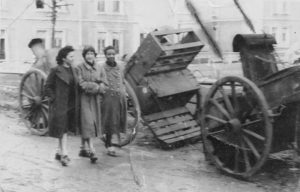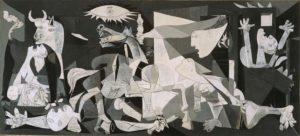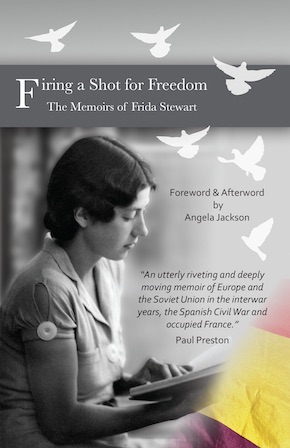A visit to the trenches
by Frida StewartOne day I heard that some of the British drivers were going to visit the trenches in the University City, and I implored them to let me go with them. My good friend Jack agreed, provided I could get my pass fixed up. For this I needed a recommendation from somebody in a position of authority, and Jack suggested that Ralph Bates, who was in charge of the information service of the International Brigades, might be able to help.
We went along and confronted him in his office, full of maps and papers and blueprints, with Brigaders of all nationalities running in and out. He was friendly but as he had never seen me before, he hummed and hawed and made out that it wouldn’t be so very easy. While I was waiting anxiously for his answer, in blew – the only word, for it was the advance of a whirlwind – Anna Louise Strong, the famous woman journalist who had travelled all over the world covering revolutionary events (or so I seemed to remember). She was one of the most impressive people I’d ever seen, large, open-faced, big innocent blue eyes, close cropped white hair. She obviously knew exactly what she wanted and had made up her mind to get it.
She descended on Comrade Bates like a typhoon on a cardboard village, and knocked him flat with her demands: she wanted a pass for the front, where the fighting was heaviest of course, it must be tomorrow at the latest, she wanted to go with so and so, and she must have a good interpreter, and would he arrange the transport and salvo conductos right now? Well, Ralph had only enough breath left after the assault to murmur, ‘Sure, Comrade Strong,’ and she swept out of the room as fast as she had come in. Later I got to know Anna Louise well, when compiling a phrase book for the International Brigade and in preparing news summaries for her.
It may have been relief at her departure, or the feeling that having acceded to all her demands, he could hardly say no to a humble request like mine. At any rate he signed and handed over a card which was the first step to being allowed to go to the trenches.
“A marvellous view, green meadows and blue mountains bathed in a gold afternoon haze. It seemed impossible that there among the dips and hollows were machine guns and men whose one idea was to kill.”
There were several other steps to be taken before one had the requisite permission, including a visit to the Ministerio de la Guerra and several of its sub-departments. We got my final salvo conducto from the jefe of the section for the University City front, whose office, swarming with militiamen in every sort of uniform, was the top room of a high house which overlooked the whole front from the University City away over rolling fields and hills to the Sierra – a marvellous view, green meadows and blue mountains bathed in a gold afternoon haze. It seemed impossible that there among the dips and hollows were machine guns and men whose one idea was to kill.
Against the blue distance the buildings of the University City rose, their square lines and yellow and russet tones making them look like the Greek temples at Paestum or Girgenti. And so they were – temples of learning and culture and science, and like Girgenti, ruined now but still beautiful.
The University had been planned as a group of buildings, one for each faculty, with a specially fine one for Medicine, and a great hospital, ‘el Clínico’, for treatment and practice. So far only a few buildings had been completed but the Spaniards were immensely proud of the ‘city’, and it was a major tragedy for them that so much of it had been destroyed. The worst damage was done to the Clínico, which for months had been fought over and remained for some time partly occupied by rebels, partly by Republican troops.

Frida (centre) in Paris with friends in front of a horse-drawn field kitchen. Courtesy of Angela Jackson and the Estate of Frida Knight
Only a short time before I saw it, the Government had decided to blow it up, and loyal troops were secretly withdrawn from it. Asturian miners, experts in the art of dynamiting, tunnelled under the building to lay mines. And up it went, with five hundred fascists inside it. The young officer who told us this added a bitter comment on Franco’s contribution to culture and science.
Armed with our safe conducts we went down into the street and set out towards the front. It was a beautiful afternoon, and in the brilliant sunshine the destruction in the war-torn street seemed even more sinister. It got more and more desolate as we went on. Every one of the houses facing the Casa de Campo had been shelled, and stood with disembowelled rooms, ceilings hanging down in ribbons, piled-up rubble, bedding, picture frames, fireplaces in a strange surrealist muddle. The street itself was ploughed up, the tramlines shooting into the air, the lamp-posts twisted and bent, the trees leafless skeletons. Not a soul in sight on the very long road, and the silence of death all round – it was all very extraordinary when one thought of the Puerta del Sol with its cheerful people and its cafés, less than two miles away.
After about a kilometre we reached the entrance to the trenches – a courtyard where a group of milicianos were enjoying their midday meal. The cook was dishing out helpings of fried sparrows and onions from a huge pan; he pressed us to taste, and I was dying to sample the dish, but time was short and we had to push on.
I had half expected the horrors of 1917 – mud, lice, rats – but was quite wrong: these trenches were clean and dry, and had been converted by their inhabitants into charming little dwellings.”
We went into the entrance hall of the Medical School, once a beautiful room of marble and stucco, but now a waste of rubble and plaster; then through into the lecture hall, with its blackboards shattered and benches turned upside down, broken, in heaps, or scattered by shells through the roof. Our guide, who had been a student here, hurried us through – he obviously hated the sight. We went on to the refectory where soldiers lived and slept. The walls were covered with frescoes they had painted depicting the glories of the Republic, and with suitable slogans as captions. They were crude daubs, but simply shouted out the vitality and gaiety of the artists.
Next we proceeded, bent nearly double, along narrow trenches leading toward the Clínico, while shells went screaming overhead, soaring across and landing with a thud in the distance. The communication trench led downwards into what seemed like the bowels of the earth. At any rate, we were feeling our way in pitch darkness – then up to daylight again and into the semi-permanent dugouts where the troops had been living for several months.
I had half expected the horrors of 1917 – mud, lice, rats – but was quite wrong: these trenches were clean and dry, and had been converted by their inhabitants into charming little dwellings with doors and windows, panelling and furniture, brought from the university classrooms, and with ingenious devices for hanging up clothes and airing them. Some had planted flowers outside the doors; others had carved their names or slogans over the entrances.
Every little compartment had a name – Casa Florida, Hotel Victoria, Hotel Rusia, Villa Pasionaria, and so on – and each competed for a prize for comfort or cultura. As we went past the doors we could hear flamenco and guitars, and when we came to one labelled Casa Lenin, where the commanding officer lodged, we were invited to step in and listen to the gramophone, of which they were fearfully proud. We sat down and heard a record, husky and trench-worn (it was the only one they possessed), while they clapped their hands and tapped with their feet – except for one, a young soldier who was sitting bent over a piece of wood which he was carving into a tray. He told us that he was from Cordoba, ‘where they do a lot of carving,’ and he hoped to win a competition for the most beautiful article produced in the trenches.
Next door to this was the company’s office, full of people working and reading by electric light, and they asked us to look round the biblioteca (library); they had carpentered shelves to hold their books, a collection ranging from arithmetic texts to economics, thrillers and picture books, over which someone had pinned up a portrait of Goethe! Surely, I thought to myself, this must be the first time war has been such a breeding ground for culture and education.
The thought that I might conceivably have killed someone, even a Francoist Moor, gave me the shudders, but I thanked him heartily and wished him success and peace as we said goodbye. I often wonder what happened to him.”
We proceeded for about a kilometre, right up to the points where occasional firing took place. There were militiamen beside their guns, waiting for a chance to pot at a Moor ensconced in the remains of the Clínico, five hundred yards away. ‘Just let one put his head up and see what happens!’ said a cheerful little Andalusian. I said he was lucky to be doing something for the final victory – or something to that effect – and he offered me his post, made me sit down by the gun, showed me which lever to lift and where to push – Hey presto! – I had fired a shot for freedom.
The thought that I might conceivably have killed someone, even a Francoist Moor, gave me the shudders, but I thanked him heartily and wished him success and peace as we said goodbye. I often wonder what happened to him, and to the guitarist and the wood carver from Cordoba. Were they among the more fortunate ones who got out of Spain in 1939? Any other supposition did not bear thinking about.
I spoke about that trip to the trenches very briefly on the radio a few nights later. The British commentator had been taken ill with jaundice (and poor thing, put on a diet which it was impossible to obtain in half-starving Madrid), and he asked me to stand in for him till he recovered. It was the beginning of many nights’ vigil in the dark little room high up in the Telefónica building, where two or three of us sat waiting to read the news or give a talk on the situation, beginning, ‘¡Aquí la voz de España!’
It was some slight satisfaction to do the talks and to feel one was meeting General Queipo de Llano on his own ground – the air. Even if one could not emulate his atrocity stories, or present the facts in quite such a horrifically picturesque way as he presented his fictions, one could at least contradict some of the wild statements he was making about the ‘Marxist beasts’ with a few home truths about the goings on of the Fascists, beside which the behaviour of the Republicans, decent by any standards, was the height of civilisation.

Guernica by Pablo Picasso, 1937. Museo Nacional Centro de Arte Reina Sofía, Madrid
Apart from broadcasting and odd jobs (such as editing a Spanish Grammar for the English-speaking International Brigaders, which I did for Anna Louise Strong, and which contained a section of phrases not usually found in such books, useful to anti-fascists in wartime – pass the ammo quick! My gunlock is rusty etc.), there was not much for me to do in Madrid; and though it was like being torn up at the roots, it seemed better to go home and try to tell something to our own people rather than to stay doing jobs I could do less well, and consuming precious Spanish rations.
I remember the journey back very clearly, in a train packed with milicianos singing and strumming their guitars, the hours between trains at Barcelona (where there were no more barricades – the POUM had been disbanded and an uneasy coalition reigned between the FAI and Republicans), visiting an International Brigade hospital at Port Bou, where I had to sleep on the pebbles of the beach, so crowded was the little town; and the return to the world this side of the Pyrenees – a quite different, only half-awake world. But in Paris I found something of Spanish awareness again – the movement for Spanish Relief and the demand for arms for Spain was tremendous, and it was impossible not to see that it was only the attitude of the British Government which prevented all the help necessary going from France to Spain. In the World Exhibition, housed in palaces along the Seine from the Trocadero to the Pont Neuf there was a corner of Spain itself: photographs and handicrafts and posters from Republican territory. In charge of it was a couple of typical milicianos, dark, bright-eyed, intelligent, and both of them, alas, typical in another way of too many of the Spanish army – short of a limb.
On one side of the pavilion hung Picasso’s Guernica – a background symbolic of all Spain’s suffering. Two thoughts crossed my mind, I remember: one was that Mr Chamberlain ought to be made to live with that picture for a year; the other, that Picasso’s painting of the final triumph of the Republic, as exuberant as Guernica is tragic, would be something to look forward to indeed.
From Firing a Shot for Freedom: The Memoirs of Frida Stewart (The Clapton Press, £9.99)
Frida Stewart (1910–96), who later published a number of books under her married name of Knight, was the daughter of the dean of Trinity College, Cambridge, and studied music at the Royal College of Music. She became involved with the Spanish Medical Aid Committee and drove an ambulance to Spain in 1937, staying on to work in a children’s hospital in Murcia. After the civil war she moved to France to help in the refugee camps and ended up being arrested in Paris after the German invasion. After escaping from the internment camp in which she was held, she made her way back to Britain, where she worked with the Free French in London. Along the way she rubbed shoulders with luminaries such as Pablo Neruda, Stephen Spender, Nancy Mitford and the composer Michael Tippet. She continued as an active political campaigner until her death. Firing a Shot for Freedom, with a foreword and afterword by Angela Jackson, is published in paperback by The Clapton Press.
Read more
Angela Jackson has published a number of books on the involvement of volunteers in the Spanish Civil War, including British Women and the Spanish Civil War (Routledge, 2002) and For Us It Was Heaven: The Passion, Grief and Fortitude of Patience Darton from the Spanish Civil War to Mao’s China (Sussex Academic Press/Cañada Blanch Centre, 2012). She also wrote the novel Warm Earth (Pegasus, 2007), based on the true stories of women who went to Spain to help the Republican cause and the International Brigades. The publication of Firing a Shot for Freedom has brought about the fulfilment of a project Angela shared with Frida in the months before her death.
The Clapton Press is an independent publisher with a particular interest in books relating to Spain.
theclaptonpress.com
@SimonDeefholts



